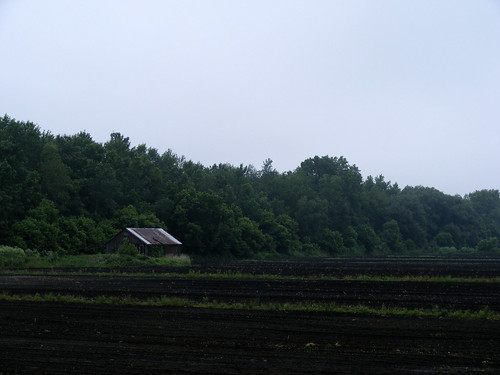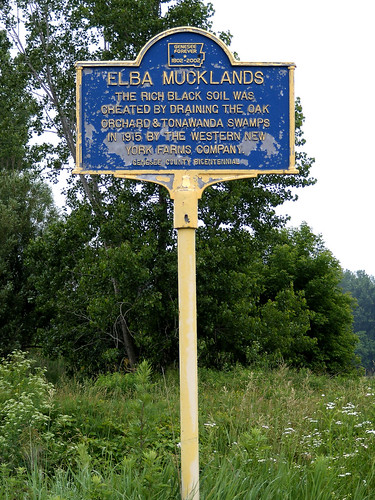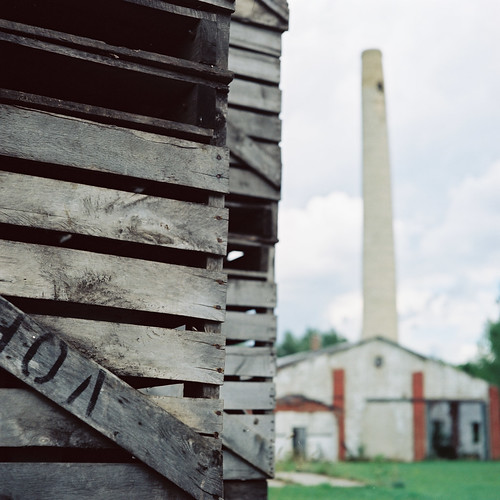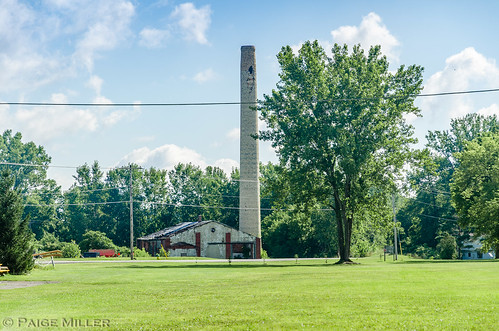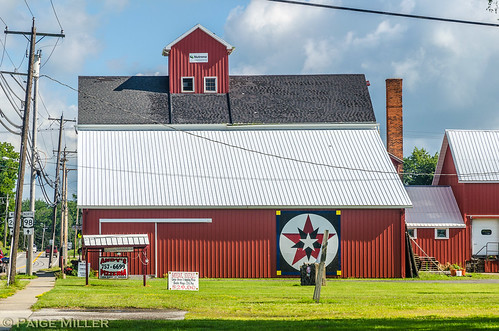Little Beard's Town was an influential and well-developed town that once existed on the western side of the Genesee River and stood in the area of where Cuylerville, New York is today. The town was named for the found, Little Beard, who was an influential and respected sachem in the late 1700s. The town was known for it's bountiful crops, which included numerous vegetables, large crops/ears of corn, and fruit orchards. The town had well over 100 dwellings, mainly well-built cabins, that were built around a town square. It and two other nearby Seneca towns were burned down during the Sullivan Expedition in 1779. Altogether, 40 Seneca villages were burned down during this expedition.
The attacks on these villages were, in part, a reaction to the Cherry Valley Massacre, where British soldiers and their Seneca and Mohawk allies attacked the Cherry Valley fort and town. Around 30 citizens were killed and an equal amount were taken into captivity. Along will lower losses and captures of soldiers of the 7th Massachusetts Regiment and militia members.
 |
By Engraver: Thomas Phillibrown from the original picture by Alonzo Chappel (1828-1887)
[Public domain], via Wikimedia Commons |
Read a historical fiction recount of the story of Little Beard's Town. From the book The Scouts of the Valley, by Joseph A. Altsheler, published in 1911. At that link you can also read the whole book or view it on Amazon here .
.
CHAPTER XXII. LITTLE BEARD'S TOWN
The trumpets called early the next morning, and the five rose, refreshed, ready for new labors. The fires were already lighted, and breakfast was cooking. Savory odors permeated the forest. But as soon as all had eaten, the army marched, going northward and westward, intending to cut through the very center of the Iroquois country. Orders had come from the great commander that the power of the Six Nations, which had been so long such a terrible scourge on the American frontier, must be annihilated. They must be made strangers in their own country. Women and children were not to be molested, but their towns must perish.
As Thayendanegea had said the night before the Battle of the Chemung, the power beyond the seas that had urged the Iroquois to war on the border did not save them. It could not. British and Tories alike had promised them certain victory, and for a while it had seemed that the promises would come true. But the tide had turned, and the Iroquois were fugitives in their own country.
The army continued its march through the wilderness, the scouts in front and heavy parties of riflemen on either flank. There was no chance for a surprise. Henry and his comrades were aware that Indian bands still lurked in the forest, and they had several narrow escapes from the bullets of ambushed foes, but the progress of the army was irresistible. Nothing could check it for a moment, however much the Indian and Tory chiefs might plan.
They camped again that night in the forest, with a thorough ring of sentinels posted against surprise, although there was little danger of the latter, as the enemy could not, for the present at least, bring a sufficient force into the field. But after the moon had risen, the five, with Heemskerk, went ahead through the forest. The Iroquois town of Kanawaholla lay just ahead, and the army would reach it on the morrow. It was the intention of the scouts to see if it was still occupied.
It was near midnight when the little party drew near to Kanawaholla and watched it from the shelter of the forest. Like most other Iroquois towns, it contained wooden houses, and cultivated fields were about it. No smoke rose from any of the chimneys, but the sharp eyes of the scouts saw loaded figures departing through a great field of ripe and waving corn. It was the last of the inhabitants, fleeing with what they could carry. Two or three warriors might have been in that group of fugitives, but the scouts made no attempt to pursue. They could not restrain a little feeling of sympathy and pity, although a just retribution was coming.
"If the Iroquois had only stood neutral at the beginning of the war, as we asked them," said Heemskerk, "how much might have been spared to both sides! Look! Those people are stopping for a moment."
The burdened figures, perhaps a dozen, halted at the far edge of the corn field. Henry and Paul readily imagined that they were taking a last look at their town, and the feeling of pity and sympathy deepened, despite Wyoming, Cherry Valley, and all the rest. But that feeling never extended to the white allies of the Iroquois, whom Thayendanegea characterized in word and in writing as "more savage than the savages themselves."
The scouts waited an hour, and then entered the town. Not a soul was in Kanawaholla. Some of the lighter things had been taken away, but that was all. Most of the houses were in disorder, showing the signs of hasty flight, but the town lay wholly at the mercy of the advancing army. Henry and his comrades withdrew with the news, and the next day, when the troops advanced, Kanawaholla was put to the torch. In an hour it was smoking ruins, and then the crops and fruit trees were destroyed.
Leaving ruin behind, the army continued its march, treading the Iroquois power under foot and laying waste the country. One after another the Indian towns were destroyed, Catherinetown, Kendaia, Kanadesaga, Shenanwaga, Skoiyase, Kanandaigua, Honeyoye, Kanaghsawa, Gathtsewarohare, and others, forming a long roll, bearing the sounding Iroquois names. Villages around Cayuga and other lakes were burned by detachments. The smoke of perishing towns arose everywhere in the Iroquois country, while the Iroquois themselves fled before the advancing army. They sent appeal after appeal for help from those to whom they had given so much help, but none came.
It was now deep autumn, and the nights grew cold. The forests blazed with brilliant colors. The winds blew, leaves rustled and fell. The winter would soon be at hand, and the Iroquois, so proud of what they had achieved, would have to find what shelter they could in the forests or at the British posts on the Canadian frontier. Thayendanegea was destined to come again with bands of red men and white and inflict great loss, but the power of the Six Nations was overthrown forever, after four centuries of victory and glory. Henry, Paul, and the rest were all the time in the thick of it. The army, as the autumn advanced, marched into the Genesee Valley, destroying everything. Henry and Paul, as they lay on their blankets one night, counted fires in three different directions, and every one of the three marked a perishing Indian village. It was not a work in which they took any delight; on the contrary, it often saddened them, but they felt that it had to be done, and they could not shirk the task.
In October, Henry, despite his youth, took command of a body of scouts and riflemen which beat up the ways, and skirmished in advance of the army. It was a democratic little band, everyone saying what he pleased, but yielding in the end to the authority of the leader. They were now far up the Genesee toward the Great Lakes, and Henry formed the plan of advancing ahead of the army on the great Seneca village known variously as the Seneca Castle and Little Beard's Town, after its chief, a full match in cruelty for the older Seneca chief, Hiokatoo. Several causes led to this decision. It was reported that Thayendanegea, Timmendiquas, all the Butlers and Johnsons, and Braxton Wyatt were there. While not likely to be true about all, it was probably true about some of them, and a bold stroke might effect much.
It is probable that Henry had Braxton Wyatt most in mind. The renegade was in his element among the Indians and Tories, and he had developed great abilities as a partisan, being skillfully seconded by the squat Tory, Coleman. His reputation now was equal at least to that of Walter Butler, and he had skirmished more than once with the vanguard of the army. Growing in Henry's heart was a strong desire to match forces with him, and it was quite probable that a swift advance might find him at the Seneca Castle.
The riflemen took up their march on a brisk morning in late autumn. The night had been clear and cold, with a touch of winter in it, and the brilliant colors of the foliage had now turned to a solid brown. Whenever the wind blew, the leaves fell in showers. The sky was a fleecy blue, but over hills, valley, and forest hung a fine misty veil that is the mark of Indian summer. The land was nowhere inhabited. They saw the cabin of neither white man nor Indian. A desolation and a silence, brought by the great struggle, hung over everything. Many discerning eyes among the riflemen noted the beauty and fertility of the country, with its noble forests and rich meadows. At times they caught glimpses of the river, a clear stream sparkling under the sun.
"Makes me think o' some o' the country 'way down thar in Kentucky," said Shif'less Sol, "an' it seems to me I like one about ez well ez t'other. Say, Henry, do you think we'll ever go back home? 'Pears to me that we're always goin' farther an' farther away."
Henry laughed.
"It's because circumstances have taken us by the hand and led us away, Sol," he replied.
"Then," said the shiftless one with a resigned air, "I hope them same circumstances will take me by both hands, an' lead me gently, but strongly, back to a place whar thar is peace an' rest fur a lazy an' tired man like me."
"I think you'll have to endure a lot, until next spring at least," said Henry.
The shiftless one heaved a deep sigh, but his next words were wholly irrelevant.
"S'pose we'll light on that thar Seneca Castle by tomorrow night?" he asked.
"It seems to me that for a lazy and tired man you're extremely anxious for a fight," Henry replied.
"I try to be resigned," said Shif'less Sol. But his eyes were sparkling with the light of battle.
They went into camp that night in a dense forest, with the Seneca Castle about ten miles ahead. Henry was quite sure that the Senecas to whom it belonged had not yet abandoned it, and with the aid of the other tribes might make a stand there. It was more than likely, too, that the Senecas had sharpshooters and sentinels well to the south of their town, and it behooved the riflemen to be extremely careful lest they run into a hornet's nest. Hence they lighted no fires, despite a cold night wind that searched them through until they wrapped themselves in their blankets.
The night settled down thick and dark, and the band lay close in the thickets. Shif'less Sol was within a yard of Henry. He had observed his young leader's face closely that day, and he had a mind of uncommon penetration.
"Henry," he whispered, "you're hopin' that you'll find Braxton Wyatt an' his band at Little Beard's town?"
"That among other things," replied Henry in a similar whisper.
"That first, and the others afterwards," persisted the shiftless one.
"It may be so," admitted Henry.
"I feel the same way you do," said Shif'less Sol. "You see, we've knowed Braxton Wyatt a long time, an' it seems strange that one who started out a boy with you an' Paul could turn so black. An' think uv all the cruel things that he's done an' helped to do. I ain't hidin' my feelin's. I'm jest itchin' to git at him."
"Yes," said Henry, "I'd like for our band to have it out with his."
Henry and Shif'less Sol, and in fact all of the five, slept that night, because Henry wished to be strong and vigorous for the following night, in view of an enterprise that he had in mind. The rosy Dutchman, Heemskerk, was in command of the guard, and he revolved continually about the camp with amazing ease, and with a footstep so light that it made no sound whatever. Now and then he came back in the thicket and looked down at the faces of the sleeping five from Kentucky. "Goot boys," he murmured to himself. "Brave boys, to stay here and help. May they go through all our battles and take no harm. The goot and great God often watches over the brave."
Mynheer Cornelius Heemskerk, native of Holland, but devoted to the new nation of which he had made himself a part, was a devout man, despite a life of danger and hardship. The people of the woods do not lose faith, and he looked up at the dark skies as if he found encouragement there. Then he resumed his circle about the camp. He heard various noises-the hoot of an owl, the long whine of a wolf, and twice the footsteps of deer going down to the river to drink. But the sounds were all natural, made by the animals to which they belonged, and Heemskerk knew it. Once or twice he went farther into the forest, but he found nothing to indicate the presence of a foe, and while he watched thus, and beat up the woods, the night passed, eventless, away.
They went the next day much nearer to the Seneca Castle, and saw sure indications that it was still inhabited, as the Iroquois evidently were not aware of the swift advance of the riflemen. Henry had learned that this was one of the largest and strongest of all the Iroquois towns, containing between a hundred and two hundred wooden houses, and with a population likely to be swollen greatly by fugitives from the Iroquois towns already destroyed. The need of caution—great caution—was borne in upon him, and he paid good heed.
The riflemen sought another covert in the deep forest, now about three miles from Little Beard's Town, and lay there, while Henry, according to his plan, went forth at night with Shif'less Sol and Tom Ross. He was resolved to find out more about this important town, and his enterprise was in full accord with his duties, chief among which was to save the vanguard of the army from ambush.
When the complete darkness of night had come, the three left the covert, and, after traveling a short distance through the forest, turned in toward the river. As the town lay on or near the river, Henry thought they might see some signs of Indian life on the stream, and from this they could proceed to discoveries.
But when they first saw the river it was desolate. Not a canoe was moving on its surface, and the three, keeping well in the undergrowth, followed the bank toward the town. But the forest soon ceased, and they came upon a great field, where the Senecas had raised corn, and where stalks, stripped of their ears and browned by the autumn cold, were still standing. But all the work of planting, tending, and reaping this great field, like all the other work in all the Iroquois fields, had been done by the Iroquois women, not by the warriors.
Beyond the field they saw fruit trees, and beyond these, faint lines of smoke, indicating the position of the great Seneca Castle. The dry cornstalks rustled mournfully as the wind blew across the field.
"The stalks will make a little shelter," said Henry, "and we must cross the field. We want to keep near the river."
"Lead on," said Shif'less Sol.
They took a diagonal course, walking swiftly among the stalks and bearing back toward the river. They crossed the field without being observed, and came into a thick fringe of trees and undergrowth along the river. They moved cautiously in this shelter for a rod or two, and then the three, without word from any one of them, stopped simultaneously. They heard in the water the unmistakable ripple made by a paddle, and then the sound of several more. They crept to the edge of the bank and crouched down among the bushes. Then they saw a singular procession.
A half-dozen Iroquois canoes were moving slowly up the stream. They were in single file, and the first canoe was the largest. But the aspect of the little fleet was wholly different from that of an ordinary group of Iroquois war canoes. It was dark, somber, and funereal, and in every canoe, between the feet of the paddlers, lay a figure, stiff and impassive, the body of a chief slain in battle. It had all the appearance of a funeral procession, but the eyes of the three, as they roved over it, fastened on a figure in the first canoe, and, used as they were to the strange and curious, every one of them gave a start.
The figure was that of a woman, a wild and terrible creature, who half sat, half crouched in the canoe, looking steadily downward. Her long black hair fell in disordered masses from her uncovered head. She wore a brilliant red dress with savage adornments, but it was stained and torn. The woman's whole attitude expressed grief, anger, and despair.
"Queen Esther!" whispered Henry. The other two nodded.
So horrifying had been the impression made upon him by this woman at Wyoming that he could not feel any pity for her now. The picture of the great war tomahawk cleaving the heads of bound prisoners was still too vivid. She had several sons, one or two of whom were slain in battle with the colonists, and the body that lay in the boat may have been one of them. Henry always believed that it was-but he still felt no pity.
As the file came nearer they heard her chanting a low song, and now she raised her face and tore at her black hair.
"They're goin' to land," whispered Shif'less Sol.
The head of the file was turned toward the shore, and, as it approached, a group of warriors, led by Little Beard, the Seneca chief, appeared among the trees, coming forward to meet them. The three in their covert crouched closer, interested so intensely that they were prepared to brave the danger in order to remain. But the absorption of the Iroquois in what they were about to do favored the three scouts.
As the canoes touched the bank, Catharine Montour rose from her crouching position and uttered a long, piercing wail, so full of grief, rage, and despair that the three in the bushes shuddered. It was fiercer than the cry of a wolf, and it came back from the dark forest in terrifying echoes.
"It's not a woman, but a fiend," whispered Henry; and, as before, his comrades nodded in assent.
The woman stood erect, a tall and stalwart figure, but the beauty that had once caused her to be received in colonial capitals was long since gone. Her white half of blood had been submerged years ago in her Indian half, and there was nothing now about her to remind one of civilization or of the French Governor General of Canada who was said to have been her father.
The Iroquois stood respectfully before her. It was evident that she had lost none of her power among the Six Nations, a power proceeding partly from her force and partly from superstition. As the bodies were brought ashore, one by one, and laid upon the ground, she uttered the long wailing cry again and again, and the others repeated it in a sort of chorus.
When the bodies-and Henry was sure that they must all be those of chiefs-were laid out, she tore her hair, sank down upon the ground, and began a chant, which Tom Ross was afterwards able to interpret roughly to the others. She sang:
The white men have come with the cannon and bayonet,
Numerous as forest leaves the army has come.
Our warriors are driven like deer by the hunter,
Fallen is the League of the Ho-de-no-sau-nee!
Our towns are burned and our fields uprooted,
Our people flee through the forest for their lives,
The king who promised to help us comes not.
Fallen is the League of the Ho-de-no-sau-nee!
The great chiefs are slain and their bodies lie here.
No longer will they lead the warriors in battle;
No more will they drive the foe from the thicket.
Fallen is the League of the Ho-de-no-sau-nee!
Scalps we have taken from all who hated us;
None, but feared us in the days of our glory.
But the cannon and bayonet have taken our country;
Fallen is the League of the Ho-de-no-sau-nee!
She chanted many verses, but these were all that Tom Ross could ever remember or translate. But every verse ended with the melancholy refrain: "Fallen is the League of the Ho-de-no-sau-nee!" which the others also repeated in chorus. Then the warriors lifted up the bodies, and they moved in procession toward the town. The three watched them, but they did not rise until the funeral train had reached the fruit trees. Then they stood up, looked at one another, and breathed sighs of relief.
"I don't care ef I never see that woman ag'in," said Shif'less Sol. "She gives me the creeps. She must be a witch huntin' for blood. She is shore to stir up the Iroquois in this town."
"That's true," said Henry, "but I mean to go nearer."
"Wa'al," said Tom Ross, "I reckon that if you mean it we mean it, too."
"There are certainly Tories in the town," said Henry, "and if we are seen we can probably pass for them. I'm bound to find out what's here."
"Still huntin' fur Braxton Wyatt," said Shif'less Sol.
"I mean to know if he's here," said Henry.
"Lead on," said the shiftless one.
They followed in the path of the procession, which was now out of sight, and entered the orchard. From that point they saw the houses and great numbers of Indians, including squaws and children, gathered in the open spaces, where the funeral train was passing. Queen Esther still stalked at its head, but her chant was now taken up by many scores of voices, and the volume of sound penetrated far in the night. Henry yet relied upon the absorption of the Iroquois in this ceremonial to give him a chance for a good look through the town, and he and his comrades advanced with boldness.
They passed by many of the houses, all empty, as their occupants had gone to join in the funeral lament, but they soon saw white men-a few of the Royal Greens, and some of the Rangers, and other Tories, who were dressed much like Henry and his comrades. One of them spoke to Shif'less Sol, who nodded carelessly and passed by. The Tory seemed satisfied and went his way.
"Takes us fur some o' the crowd that's come runnin' in here ahead o' the army," said the shiftless one.
Henry was noting with a careful eye the condition of the town. He saw that no preparations for defense had been made, and there was no evidence that any would be made. All was confusion and despair. Already some of the squaws were fleeing, carrying heavy burdens. The three coupled caution with boldness. If they met a Tory they merely exchanged a word or two, and passed swiftly on. Henry, although he had seen enough to know that the army could advance without hesitation, still pursued the quest. Shif'less Sol was right. At the bottom of Henry's heart was a desire to know whether Braxton Wyatt was in Little Beard's Town, a desire soon satisfied, as they reached the great Council House, turned a corner of it, and met the renegade face to face.
Wyatt was with his lieutenant, the squat Tory, Coleman, and he uttered a cry when he saw the tall figure of the great youth. There was no light but that of the moon, but he knew his foe in an instant.
"Henry Ware!" he cried, and snatched his pistol from his belt.
They were so close together that Henry did not have time to use a weapon. Instinctively he struck out with his fist, catching Wyatt on the jaw, and sending him down as if he had been shot. Shif'less Sol and Tom Ross ran bodily over Coleman, hurling him down, and leaping across his prostrate figure. Then they ran their utmost, knowing that their lives depended on speed and skill.
They quickly put the Council House between them and their pursuers, and darted away among the houses. Braxton Wyatt was stunned, but he speedily regained his wits and his feet.
"It was the fellow Ware, spying among us again!" he cried to his lieutenant, who, half dazed, was also struggling up. "Come, men! After them! After them!"
A dozen men came at his call, and, led by the renegade, they began a search among the houses. But it was hard to find the fugitives. The light was not good, many flitting figures were about, and the frantic search developed confusion. Other Tories were often mistaken for the three scouts, and were overhauled, much to their disgust and that of the overhaulers. Iroquois, drawn from the funeral ceremony, began to join in the hunt, but Wyatt could give them little information. He had merely seen an enemy, and then the enemy had gone. It was quite certain that this enemy, or, rather, three of them, was still in the town.
Henry and his comrades were crafty. Trained by ambush and escape, flight and pursuit, they practiced many wiles to deceive their pursuers. When Wyatt and Coleman were hurled down they ran around the Council House, a large and solid structure, and, finding a door on the opposite side and no one there or in sight from that point, they entered it, closing the door behind them.
They stood in almost complete darkness, although at length they made out the log wall of the great, single room which constituted the Council House. After that, with more accustomed eyes, they saw on the wall arms, pipes, wampum, and hideous trophies, some with long hair and some with short. The hair was usually blonde, and most of the scalps had been stretched tight over little hoops. Henry clenched his fist in the darkness.
"Mebbe we're walkin' into a trap here," said Shif'less Sol.
"I don't think so," said Henry. "At any rate they'd find us if we were rushing about the village. Here we at least have a chance."
At the far end of the Council House hung mats, woven of rushes, and the three sat down behind them in the very heart of the Iroquois sanctuary. Should anyone casually enter the Council House they would still be hidden. They sat in Turkish fashion on the floor, close together and with their rifles lying across their knees. A thin light filtered through a window and threw pallid streaks on the floor, which they could see when they peeped around the edge of the mats. But outside they heard very clearly the clamor of the hunt as it swung to and fro in the village. Shif'less Sol chuckled. It was very low, but it was a chuckle, nevertheless, and the others heard.
"It's sorter takin' an advantage uv 'em," said the shiftless one, "layin' here in thar own church, so to speak, while they're ragin' an' tearin' up the earth everywhar else lookin' fur us. Gives me a mighty snug feelin', though, like the one you have when you're safe in a big log house, an' the wind an' the hail an' the snow are beatin' outside."
"You're shorely right, Sol," said Tom Ross.
"Seems to me," continued the irrepressible Sol, "that you did git in a good lick at Braxton Wyatt, after all. Ain't he unhappy now, bitin' his fingers an' pawin' the earth an' findin' nothin'? I feel real sorry, I do, fur Braxton. It's hard fur a nice young feller to have to suffer sech disappointments."
Shif'less Sol chuckled again, and Henry was forced to smile in the darkness. Shif'less Sol was not wholly wrong. It would be a bitter blow to Braxton Wyatt. Moreover, it was pleasant where they sat. A hard floor was soft to them, and as they leaned against the wall they could relax and rest.
"What will our fellows out thar in the woods think?" asked Tom Ross.
"They won't have to think," replied Henry. "They'll sit quiet as we're doing and wait."
The noise of the hunt went on for a long time outside. War whoops came from different points of the village. There were shrill cries of women and children, and the sound of many running feet. After a while it began to sink, and soon after that they heard no more noises than those of people preparing for flight. Henry felt sure that the town would be abandoned on the morrow, but his desire to come to close quarters with Braxton Wyatt was as strong as ever. It was certain that the army could not overtake Wyatt's band, but he might match his own against it. He was thinking of making the attempt to steal from the place when, to their great amazement, they heard the door of the Council House open and shut, and then footsteps inside.
Henry looked under the edge of the hanging mat and saw two dusky figures near the window.























